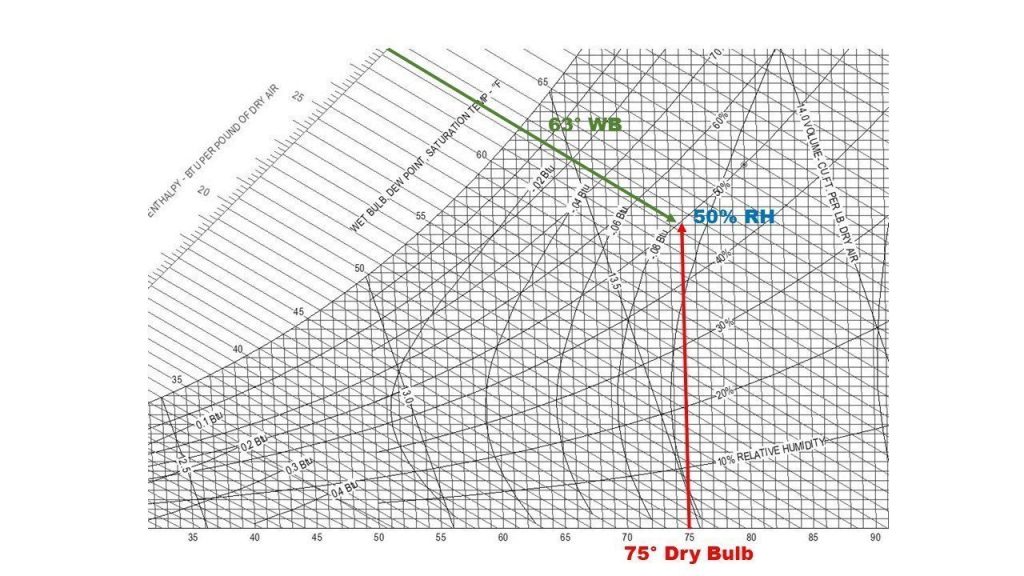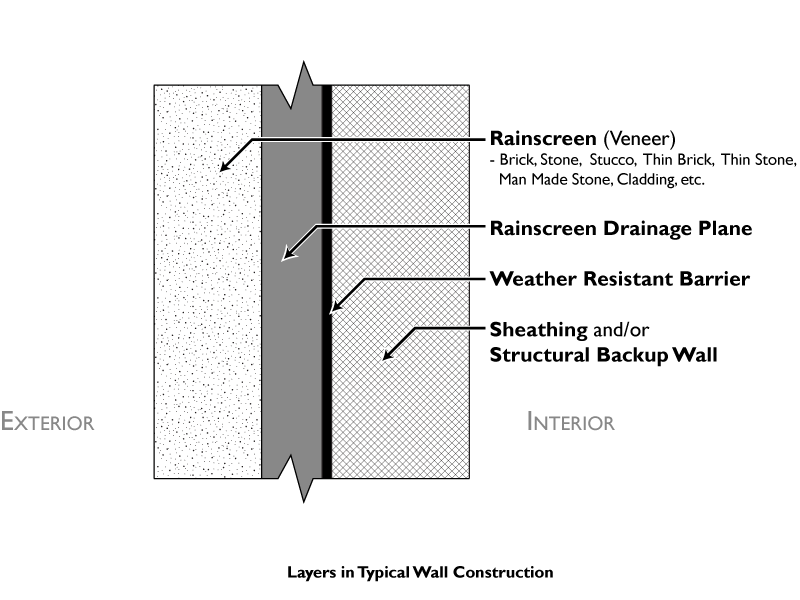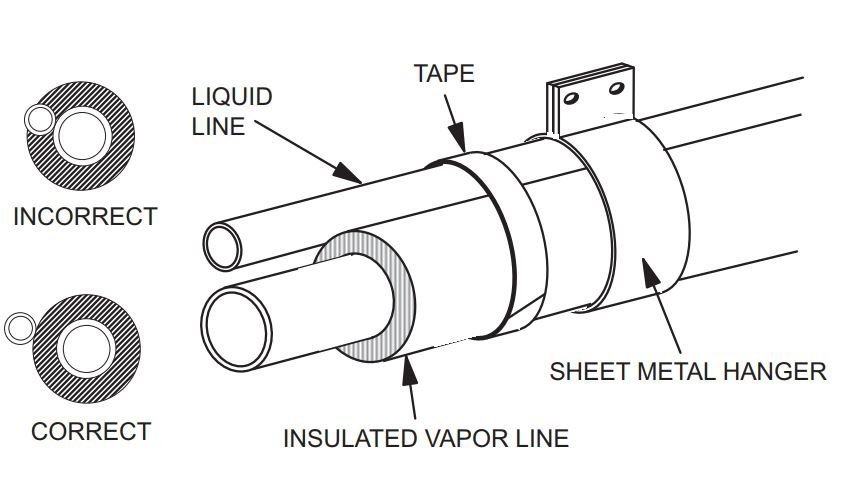Get Tech Tips
Subscribe to free tech tips.
The Strange Behavior of Moisture in Stuff

Water is weird and water vapor is even weirder – before we dive down this rabbit hole lets define some terms
To better understand the behavior of moisture in materials, we need to first define some essential terms and concepts:
- Relative Humidity (RH): The ratio of the amount of water vapor in the air to the maximum amount of water vapor the air can hold at a given temperature, expressed as a percentage.
- Total humidity: also known as absolute humidity, is a measure of the actual amount of water vapor present in the air, regardless of the temperature or air pressure. It is typically expressed in grams of water vapor per cubic meter of air (g/m³) or grains of water vapor per pound of dry air (gr/lb).
- Vapor Pressure: The force exerted by a gas or vapor in equilibrium with its solid or liquid phase. It is directly related to the concentration of water molecules in the air.
- Vapor Diffusion: The process of moisture movement through a barrier due to differences in vapor pressure. It occurs when there is a difference in vapor pressure between two sides of a barrier, causing water molecules to move from the area of higher vapor pressure to the area of lower vapor pressure.
- Sorption: The process by which materials absorb and release moisture in response to changes in the relative humidity of their environment.
- Equilibrium Moisture Content (EMC): A term used to describe the moisture content at which a hygroscopic material, such as wood, reaches a balance with the relative humidity and temperature of the surrounding environment. At this point, the material neither gains nor loses moisture.
Now that we have a foundation, let's explore the different ways moisture interacts with materials and why it matters.
Moisture Movement Through Barriers: Moisture can move through barriers like wooden walls due to differences in vapor pressure, a process known as vapor diffusion. This movement aims to equalize the vapor pressure on both sides of the barrier.
It's worth noting, the amount of water that moves via vapor diffusion vs. the amount that moves through air leaks makes vapor diffusion a minor factor in comparison in most cases. Also, some of you may be saying “Why say vapor pressure and not dew point?”. This is becasue while dewpoint and vapor pressure may seem proportional they actually are not, whereas saying vapor pressure and total moisture content are proportional and an be used interchangeably for the sake of this article. Wanna know why? look up the Clausius-Clapeyron equation
Let's make understanding how this works more simple…
Imagine a sealed container divided into two compartments by a semi-permeable membrane that allows vapor water molecules to pass through. One side of the container has a high concentration of water molecules (high vapor pressure), while the other side has a lower concentration (low vapor pressure). Over time, water molecules will move through the membrane from the high vapor pressure side to the low vapor pressure side, attempting to equalize the vapor pressure on both sides.
In practical applications, understanding vapor diffusion is crucial for designing vapor barriers in walls to prevent moisture issues and allow drying based on differences in total moisture content (vapor pressure).

Moisture Content and Relative Humidity: The moisture content of materials like wood is primarily influenced by the relative humidity of their environment, a property known as sorption. When RH is high, materials like wood absorb moisture, while they release moisture when RH is low.
Imagine a guitar made of wood. When stored in a room with high RH, the wood absorbs moisture, causing the guitar to swell and potentially affecting its sound quality and structural integrity. Conversely, if the guitar is stored in a room with low RH, the wood releases moisture, causing it to shrink and possibly leading to cracks or other damage. To maintain the guitar's condition, it is crucial to control the environment's RH.
Practical Implications: Understanding the relationship between relative humidity, vapor pressure, and moisture content in materials is essential for various applications:
- Protecting instruments: Ensuring instruments made of wood, such as guitars or violins, are stored in environments with controlled RH prevents damage due to moisture absorption or release.
- Preserving wood trim work: High-quality trim work needs to acclimate to standard indoor conditions and RH before installation and painting to prevent cracking or warping.
- Managing indoor air quality: Controlling relative humidity in living spaces helps maintain a comfortable and healthy environment by preventing the growth of mold and mildew, which thrive in high humidity conditions.
- Building design and construction: Understanding vapor diffusion and the behavior of moisture in materials is essential for designing vapor barriers in walls and selecting appropriate insulation. Proper construction techniques help prevent moisture issues, such as condensation, mold growth, or structural damage, by allowing the building to dry effectively.

Let's use a thought experiment on the guitar with some numbers for you math nerds
Let's say we have a guitar in a room that is in a 40 degree room at 80% RH and we move it to a room at 100 degress F with 50% rh.
The guitar would still release moisture even though it was moved from an environment with lower vapor pressure and higher RH to an environment with higher vapor pressure and lower RH. Let's break down this scenario and explain why this occurs:
Initial Environment (40°F, 80% RH): In this cold environment, the air's capacity to hold moisture is significantly lower than in a warmer environment. However, because the relative humidity is high (80%), the air is holding a large percentage of its maximum moisture capacity at this temperature. To convert RH to vapor pressure, we can calculate that the saturation vapor pressure (Psat) for the 40°F environment is approximately 0.36 PSI. At 80% RH, the actual vapor pressure (P) is 0.29 PSI.
New Environment (100°F, 50% RH): In this warmer environment, the air can hold much more moisture than in the cold environment. However, because the relative humidity is only 50%, the air is holding only half of its maximum moisture capacity at this temperature. Using the same approximation, the saturation vapor pressure (Psat) for the 100°F environment is approximately 1.92 PSI. At 50% RH, the actual vapor pressure (P) is 0.96 PSI.
In both cases, the wood in the guitar will reach an equilibrium moisture content (EMC) based on the relative humidity of its environment. When the guitar is moved from the 40°F, 80% RH environment (0.29 PSI) to the 100°F, 50% RH environment (0.96 PSI), the vapor pressure in the new environment is higher, but the relative humidity is lower. The guitar's moisture content responds more to the relative humidity than the vapor pressure because the wood's moisture exchange with the surrounding air is driven by the air's capacity to hold moisture (RH) rather than the absolute amount of moisture in the air (vapor pressure).
In this scenario, when the guitar is moved from the 40°F, 80% RH environment to the 100°F, 50% RH environment, its equilibrium moisture content would decrease from approximately 14.4% to 9%. This change in moisture content occurs because the guitar's wood responds more to the relative humidity than the vapor pressure.
As a result, even though the vapor pressure is higher in the new environment, the lower relative humidity prompts the guitar's wood to release moisture, as it aims to reach a new equilibrium moisture content based on the lower relative humidity. This process occurs because the hygroscopic properties of the wood cause it to absorb and release moisture in response to changes in relative humidity, rather than the absolute amount of moisture in the air (vapor pressure).
Conclusion: The behavior of moisture in materials like wood can be weird, with moisture content responding more to relative humidity than to vapor pressure. By understanding the connection between temperature, relative humidity, vapor pressure, and moisture content, we can better appreciate why this strange phenomenon occurs.
In essence, the moisture content of hygroscopic materials, such as wood, is primarily influenced by the capacity of the surrounding air to hold moisture, which is affected by both temperature and humidity. This is why wood and other similar materials absorb moisture in high relative humidity environments and release moisture in low relative humidity environments, even if there are differences in vapor pressure.
In summary…
Water vapor moves THROUGH stuff based on a difference in total moisture / vapor pressure and it is held IN STUFF based on the RH% of the air.
Simple….
— Bryan
References for haters, doubters and faithful fact checkers
U.S. Forest Service, Forest Products Laboratory: “Wood Handbook – Wood as an Engineering Material” – Chapter 4: Moisture Relations and Physical Properties of Wood. This chapter provides an in-depth explanation of wood moisture content and its relationship with relative humidity
U.S. Department of Energy: “Vapor Diffusion” – This article explains vapor diffusion and its role in moisture movement through building materials.
Building Science Corporation: “Understanding Vapor Barriers” – This article covers the topic of vapor barriers and how they work in building design and construction.
Link: https://www.buildingscience.com/documents/digests/bsd-106-understanding-vapor-barriers
National Wood Flooring Association (NWFA): “Relative Humidity and Wood Flooring” – This article provides insights into the effects of relative humidity on wood flooring and how to manage it.











Comments
“The guitar’s moisture content responds more to the relative humidity than the vapor pressure because the wood’s moisture exchange with the surrounding air is driven by the air’s capacity to hold moisture (RH) rather than the absolute amount of moisture in the air (vapor pressure).”
I’m no engineer but it seems RH is a fictitious existence. Isn’t the quantity of energy units the reality thus causing pressure differences?
I think about this all the time and can’t wrap my head around it. We battle this every summer in TN.
Wouldn’t the initial energy transfer be in the sensible change of the wood’s temp? This would than change the VP. What makes the transfer of sensible energy “easier” than vapor anyways? The equilibrium of moisture grains seem to follow the equilibrium of sensible energy. Am I crazy?
“The guitar’s moisture content responds more to the relative humidity than the vapor pressure because the wood’s moisture exchange with the surrounding air is driven by the air’s capacity to hold moisture (RH) rather than the absolute amount of moisture in the air (vapor pressure).”
I’m no engineer but it seems RH is a fictitious existence. Isn’t the quantity of energy units the reality thus causing pressure differences?
I think about this all the time and can’t wrap my head around it. We battle this every summer in TN.
Wouldn’t the initial energy transfer be in the sensible change of the wood’s temp? This would than change the VP. What makes the transfer of sensible energy “easier” than vapor anyways? The equilibrium of moisture grains seem to follow the equilibrium of sensible energy. Am I crazy?
“Isn’t the quantity of energy units the reality, thus causing pressure differences?”
Indeed, energy is a crucial factor affecting both temperature and vapor pressure. As water molecules in the air gain energy, they move faster, leading to an increase in vapor pressure. However, when considering the moisture exchange of hygroscopic materials like wood, it’s the relative humidity (RH) that primarily drives the process, as explained in the previous response.
“Wouldn’t the initial energy transfer be in the sensible change of the wood’s temp? This would then change the VP.”
Yes, when a wooden object is moved between environments with different temperatures, there will be a sensible heat exchange until the object reaches thermal equilibrium with the new environment. This temperature change does affect the vapor pressure of the moisture within the wood. However, the moisture exchange with the surrounding air is primarily driven by RH because of the wood’s hygroscopic properties and its affinity for moisture in relation to the air’s capacity to hold moisture.
“What makes the transfer of sensible energy ‘easier’ than vapor anyway?”
The transfer of sensible heat and moisture (latent heat) are two different processes. Sensible heat transfer occurs due to a difference in temperature between two objects or environments, while moisture transfer involves the movement of water molecules from an area of high vapor pressure to an area of low vapor pressure. Both processes can occur simultaneously, but the primary driver of moisture exchange in hygroscopic materials like wood is the relative humidity, as it directly impacts the wood’s affinity for moisture and equilibrium moisture content.
“The equilibrium of moisture grains seems to follow the equilibrium of sensible energy. Am I crazy?”
You’re not crazy for noticing a connection between sensible energy and moisture equilibrium. Both temperature and moisture content are interrelated factors that influence the overall behavior of wood and other hygroscopic materials. However, it’s important to understand that the wood’s moisture exchange with the surrounding air is primarily driven by the air’s capacity to hold moisture (RH) rather than the absolute amount of moisture in the air (vapor pressure). The wood’s moisture content will change in response to the surrounding environment’s RH to reach an equilibrium moisture content, which is also affected by the wood’s temperature.
“Isn’t the quantity of energy units the reality, thus causing pressure differences?”
Indeed, energy is a crucial factor affecting both temperature and vapor pressure. As water molecules in the air gain energy, they move faster, leading to an increase in vapor pressure. However, when considering the moisture exchange of hygroscopic materials like wood, it’s the relative humidity (RH) that primarily drives the process, as explained in the previous response.
“Wouldn’t the initial energy transfer be in the sensible change of the wood’s temp? This would then change the VP.”
Yes, when a wooden object is moved between environments with different temperatures, there will be a sensible heat exchange until the object reaches thermal equilibrium with the new environment. This temperature change does affect the vapor pressure of the moisture within the wood. However, the moisture exchange with the surrounding air is primarily driven by RH because of the wood’s hygroscopic properties and its affinity for moisture in relation to the air’s capacity to hold moisture.
“What makes the transfer of sensible energy ‘easier’ than vapor anyway?”
The transfer of sensible heat and moisture (latent heat) are two different processes. Sensible heat transfer occurs due to a difference in temperature between two objects or environments, while moisture transfer involves the movement of water molecules from an area of high vapor pressure to an area of low vapor pressure. Both processes can occur simultaneously, but the primary driver of moisture exchange in hygroscopic materials like wood is the relative humidity, as it directly impacts the wood’s affinity for moisture and equilibrium moisture content.
“The equilibrium of moisture grains seems to follow the equilibrium of sensible energy. Am I crazy?”
You’re not crazy for noticing a connection between sensible energy and moisture equilibrium. Both temperature and moisture content are interrelated factors that influence the overall behavior of wood and other hygroscopic materials. However, it’s important to understand that the wood’s moisture exchange with the surrounding air is primarily driven by the air’s capacity to hold moisture (RH) rather than the absolute amount of moisture in the air (vapor pressure). The wood’s moisture content will change in response to the surrounding environment’s RH to reach an equilibrium moisture content, which is also affected by the wood’s temperature.
To leave a comment, you need to log in.
Log In